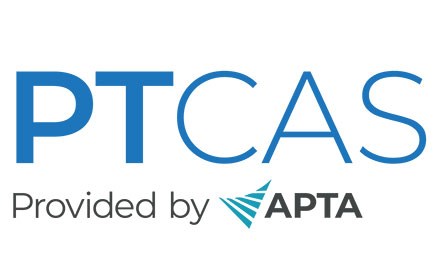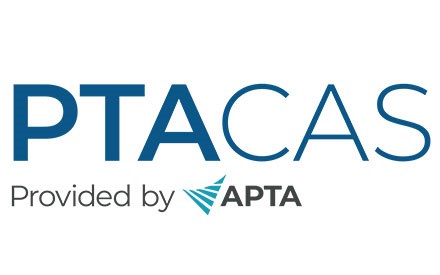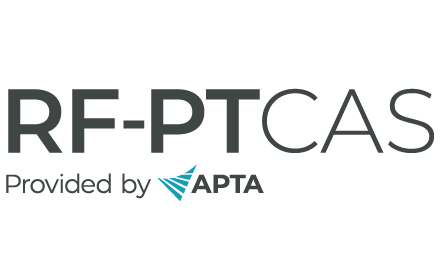By using this site, you are consenting to our use of cookies. To find out more visit our privacy policy.
In an effort to simplify the application process to physical therapist assistant (PTA), Doctor of Physical Therapy (DPT), and physical therapy residency and fellowship education programs, APTA offers three centralized application services:
- Apply to PTA education program through the Physical Therapist Assistant Centralized Application Service (PTACAS)
- Apply to DPT programs through the Physical Therapist Centralized Application Service (PTCAS)
- Apply to PT residency and fellowship education programs through the Residency and Fellowship Physical Therapist Centralized Application Service (RF-PTCAS)
Each CAS allows applicants to use a single web-based application and one set of materials to apply to multiple education programs. The services are each a product of the American Physical Therapy Association (APTA), headquartered in Alexandria, VA, and are administered by Liaison International, an education information technology company headquartered in Watertown, MA.
Each CAS has its own set of core requirements for applicants that must be completed prior to submitting an application. It is the applicant's responsibility to read and follow all CAS and program-specific instructions requirements.
Benefits of a Centralized Application Service
The education programs participating in a CAS can use the service to:
- Significantly decrease the administrative burden on admissions committees and staff by reducing data entry and filing responsibilities.
- Promote the program to a broader spectrum of prospective applicants in order to recruit a qualified applicant pool that is diverse in terms of race, ethnicity, background, and geographic location.
- More effectively compete with other health profession programs that utilize a centralized application service including, but not limited to allopathic medicine, osteopathic medicine, dentistry, dental hygiene, veterinary medicine, nursing, pharmacy, physician assistants, occupational therapy, and podiatry.
- More effectively promote physical therapy careers to pre-health profession advisors. Advisors are accustomed to centralized services and find it helpful in advising applicants who wish to apply to multiple programs.
- Reduce the expense of developing and maintaining a paper or web-based application process at the program level.
- More easily contact prospective applicants before their applications are processed in order to send recruitment and/or supplemental application information and increase the program's acceptance yield.
- Capture more comprehensive applicant data in which to make admission decisions.
- Analyze local application trends against peer and national data in order to develop more effective recruitment strategies.
- Contribute to and access a rich database of applicant data that could eventually eliminate the need for surveys on student data.
- Use CAS generated GPAs to eliminate the time-consuming grade conversion and GPA process at the local level.
- Check the real-time status of an applicant's file, transcripts, and references online at any point in the application cycle.
- Export applicant data from the free web-based admissions software into a local student information system or database.
Centralized application services provide many benefits to applicants, including:
- Offer a simple, efficient process to apply to multiple education programs using a single web-based application.
- Provide a standardized application form that reduces or eliminates duplicate data entry.
- Reduce or eliminate the need for duplicate letters of reference and transcripts for those applying to more than one education program.
- Provide program-specific admission requirements in an easy-to-find and standardized format.
- Provide direct access to the application that is separate from other degrees or disciplines offered by the institution.
- Provide a real-time status tool so that applicants may check the status of their application, transcripts, and letters of reference online at any time.
- Offer applicants an online checklist and admission requirement summaries to help them more easily navigate the complexities of the admissions process.
- Decrease the number of applicant errors and omissions through the use of validation rules in the Web application and the transcript verification process.
- Allow applicants to access the application from any device with internet access. Applicants can close and re-open the application as often as desired prior to submission.
- Facilitate applications to a broader array of institutions which may increase the likelihood that qualified applicants will enroll in an education program.
- Provide the applicant one point of contact for all customer support needs.
- Provide an online message center that displays emails sent to the applicant. This tool protects against lost emails due to spam filters.
- Facilitate the application fee payment process by allowing applicants to make online credit card payments over a secure web site using a real-time payment system.
Pre-health profession advisors and guidance counselors can use the centralized application services to:
- Write one letter of reference per applicant, regardless of the number of programs designated by the applicant.
- More easily guide students through the admissions process.
- Access the Universal Advisor Portal to check on the status of their students or alumni who have authorized the CAS to release this information to advisors. (PTCAS Only)
- More easily track the acceptance rates of their students into education programs.
- Learn more about physical therapy careers which will assist them in counseling qualified students.
Each CAS will enable the physical therapy profession to:
- Determine the number of applicants versus applications to better track national application trends.
- Increase diversity in the profession by better analyzing the under-represented minority applicant pool. Better data on the size of this pool, standardized identification of racial and ethnic categories, comparative data on application metrics, and accurate information on matriculation of applicants from this pool may be used to improve diversity in physical therapy programs.
- Compare physical therapy profession applicant trends to other health professions that utilize a centralized process.
- Generate national data regarding the entire and accepted pool of applicants in regards to applicant to application ratio, state of residency, sex, gender, age, race, ethnicity, academic criteria, and many other selected fields to focus national student recruitment efforts.
- Better promote careers in physical therapy and information about the PT admissions process to a more accessible audience via the APTA website.
- Use applicant data to support arguments for increased federal funding in such areas as HRSA Titles IV and VIII of the Public Health Service Act, Health Career Opportunity Programs (HCOP), Centers of Excellence (COE), Financial Aid loans and grants, and research grants.
- Better track applicants through the educational program and throughout their professional careers.


